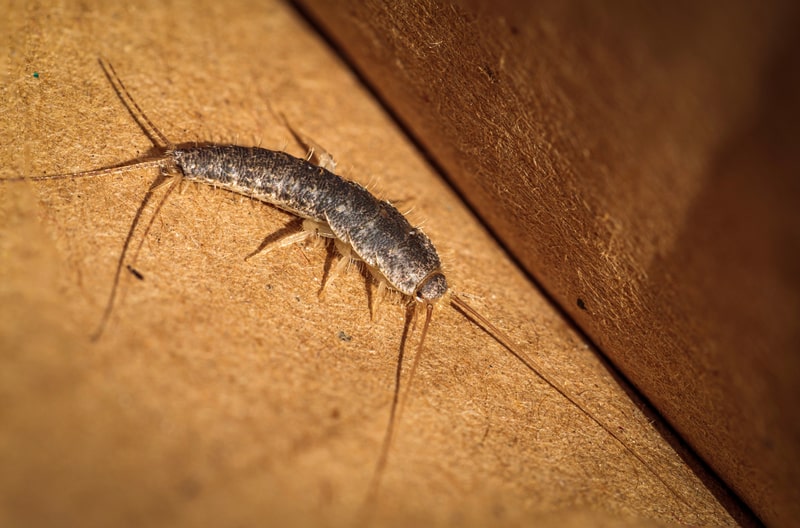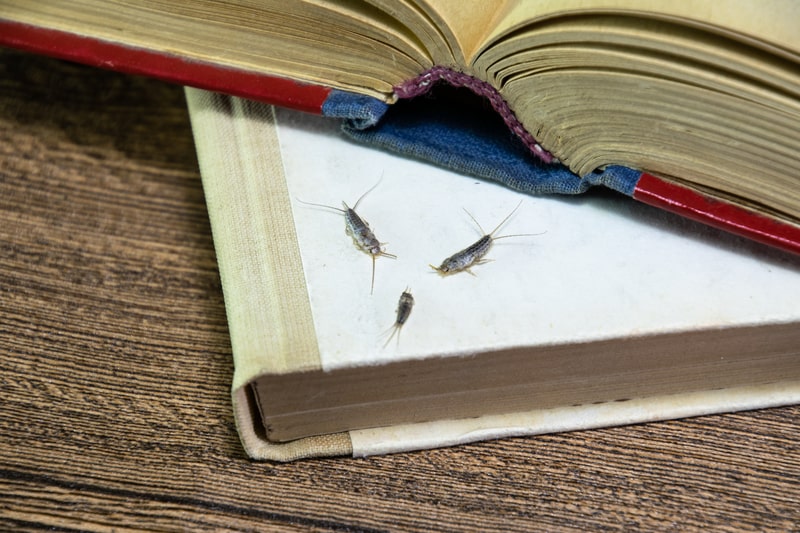Despite their aquatic-sounding name, silverfish are not related to fish. These tiny insects are named for their fish-like appearance and quick movements. In reality, silverfish are pests that can damage your belongings. If you keep finding these unpleasant neighbors in your home, it's time to take action.
What are silverfish?
Silverfish are among the oldest insects in the world. Fossils date them back to the Devonian period of the Paleozoic Era, making this species nearly 400 million years old.
Although unsightly in appearance, silverfish generally aren't dangerous to humans. However, they can easily infest your home and damage your belongings, and can even trigger allergies in some people.

What do silverfish look like?
Adult silverfish are around ¾ inches long. This silver-colored pest has a shiny body with fine fish-like scales and two front antennae. It also has three bristle-like appendages on the rear end of the body.

Silverfish Lifecycle Stages
Silverfish exhibit ametabolous metamorphosis, meaning no metamorphosis or transformation. An immature silverfish is smaller but nearly identical to an adult silverfish. It can take between three months to four years for the silverfish to transform from an egg to an adult.
Silverfish Reproduction
When silverfish mate, the male insect releases a package with its sperm onto the ground. The female insect picks it up with a special organ and pushes the bag into its body. Inside, sperm leaves the package and fertilizes the eggs.
Silverfish Eggs
The female silverfish lays eggs in any suitable crack it can find. These eggs are soft, white, oval, and only about one millimeter long. It takes them several weeks or months to hatch, depending on how safe and favorable the environment is.
Silverfish Nymphs
When it comes to these arthropods, there isn't a silverfish larvae stage. Once it emerges from the egg, a silverfish nymph looks like a smaller (less than 1/8 inches long) version of an adult silverfish. However, it's a little lighter and less shiny. As it grows, the nymph sheds its skin several times and eventually grows a silvery adult coat. Shed skins can mingle with dust in homes and may exacerbate allergy symptoms.
Silverfish Adults
Silverfish adults have tear-shaped bodies that can be as small as ½ of an inch and as big as ¾ of an inch.
While most of the silverfish are silver or gray, some can be closer to brown in color. The tiny and almost transparent appearance of these insects makes it easy for them to hide from predators (or your shoes). Silverfish typically live about 3 years, meaning they might be tenants in your home for a while if undetected.
Silverfish Diet and Feeding
What do silverfish eat? With regard to some of your most cherished belongings, nothing is safe from silverfish. Silverfish need starch, protein, and carbohydrates to survive. That's why they eat fabric, paper, glue, wallpaper, and plaster. They also enjoy dried pasta, oats, coffee, sugar, and other human food.
If your clothing has been starched, silverfish will also eat your clothes – particularly those made from natural fibers like cotton, silk, rayon, and even leather. These fabrics all contain components essential to a silverfish's diet. Silverfish can also leave behind holes and yellow stains on your clothing.
Other belongings that silverfish tend to damage are books and wallpaper. These items all contain starch and the substances silverfish need to survive.

Where do silverfish come from?
These nocturnal insects prefer damp and moist places, and thrive in temperatures between 70 and 80 degrees Fahrenheit. Attracted by food and humidity, they either infest your house from the outside or, if you live in an apartment home, can easily creep over to your residence from neighboring units.
Silverfish can also hitch a ride in a box, carton, or even a book that you bring home from another location.
During what seasons do silverfish come out?
Silverfish prefer humid and moist environments. With this in mind, they are highly active in the spring. However, silverfish infestations often occur in the wintertime when these pests seek a warm place to stay.
Where do silverfish live?
Silverfish like humid crevices with a food source nearby. In nature, they live under rocks, logs, and in tree bark. In houses, they prefer attics, basements, laundry rooms, bathrooms, and kitchens.
Do silverfish bite?
Silverfish are not aggressive and do not don't feed on blood. Rather, they subsist on a diet dominated by starches and carbohydrates – munching on books, paper, and wallpaper. They don't attack humans or animals.
If they get scared, these tiny insects run and hide. That's why biting is extremely rare among silverfish. If it does happen by accident, you would never feel it because a silverfish's jaws are very soft. If a silverfish does “bite," you'll see more of a light scrape on the skin than an actual puncture, compared to the bites of other common household pests.
Are silverfish harmful to my health?
In most cases, silverfish aren't harmful. They rarely bite and do not possess the capacity to puncture the skin due to their weak jaws. Silverfish do not carry disease or cause an infection. However, these pests can trigger allergic reactions and cause respiratory problems. Some people are allergic to their shed scales and droppings.
What causes silverfish infestations?
Silverfish loves dark places, high humidity, and readily available food sources. So leaky pipes, cracks in walls, and food without containers can be highly appealing to these pests and tempt them into your home.
How serious are silverfish problems?
While seemingly harmless at first, silverfish can infest your entire home, ruin your belongings, and settle in your food.
A silverfish infestation could also mean that you have bigger problems with your house that include cracks that provide entry points for the insects and hidden water damage.
How can I help prevent silverfish from getting into my home? In order to help prevent silverfish from infesting your home, you need to make your house unattractive to these insects:
- Tend to areas that have moisture and humidity. Consider investing in a dehumidifier for these zones of your home. Carefully look for areas where you may have leaks that allow water to pool, creating a moist environment.
- Clean regularly. Regularly cleaning, vacuuming, and dusting your home can help to keep silverfish at bay. Silverfish actually feed on dust, so a dusty environment (such as an attic, or around undusted baseboards) can make your home all the more tempting for these creatures. They also like to lurk in areas with lots of clutter, giving them ample places to hide and seek out food. Be sure to put your belongings away in an organized manner, creating less of a safe haven for silverfish.
- Place food in airtight containers. Silverfish Bran Flakes, anyone? Ugh. No one wants to sit down to breakfast and open a box of cereal only to find a bunch of slimy silverfish hopping into your bowl. Since silverfish feed on starches, carb-heavy breakfast cereals are an ideal food source for them. Placing cereal, flour, pet food, and other cardboard boxes of food in airtight containers can help reduce the risk of having unwanted guests at your breakfast table.
Why do I have silverfish in my house?
There are a number of reasons why silverfish may have taken up residence in your home:
- They came over from the neighbors – especially if you live in a multi-unit dwelling such as an apartment or condominium.
- Some silverfish may have hitched a ride in an item you brought into your home. If these creatures were pregnant or were able to breed once inside your home, they could add more silverfish to their ranks.
- You have water damage and open food containers that attract these pests, creating an environment that is hospitable to them via added moisture and humidity, as well as ample food sources.
- You have cracks in walls or around windows and doors that allow silverfish to slip through.
Why do I have silverfish in my bathroom?
Bathrooms are perfect places for silverfish since they provide excellent hiding spots, plenty of water, high humidity levels, and sufficient food. If you take long, hot showers, this can create dampness and humidity that is appealing to silverfish.
What are the signs of a silverfish infestation?
The common signs of silverfish infestation include silverfish droppings, shed scales, yellow stains (on books, clothing cardboard boxes, or papers), and chewed holes in books, wallpaper, clothing, and linens. If you have an infestation, you are likely to see live silverfish lurking around the house, crawling up and down your walls or hiding inside bookshelves – among other places.
How To Help Get Rid of Silverfish
Although DYI efforts may help to curb a silverfish infestation, near total elimination is only possible if you take advantage of professional pest control services. You can try to defend against silverfish on your own by:
- Putting food in airtight containers.
- Vacuuming and cleaning carpets and upholstery regularly.
- Reducing humidity by getting a dehumidifier and improving ventilation.
- Using silverfish traps.
How Terminix® Helps You With Silverfish Control
Terminix® offers professional silverfish control services. We use the latest technologies to identify favorite silverfish spots and apply chemicals to get rid of all eggs, nymphs, and adults in your home.
Our experts will also provide detailed advice on what to do to prevent a silverfish infestation in the future.
Got a silverfish problem? Contact us for a free inspection today!


